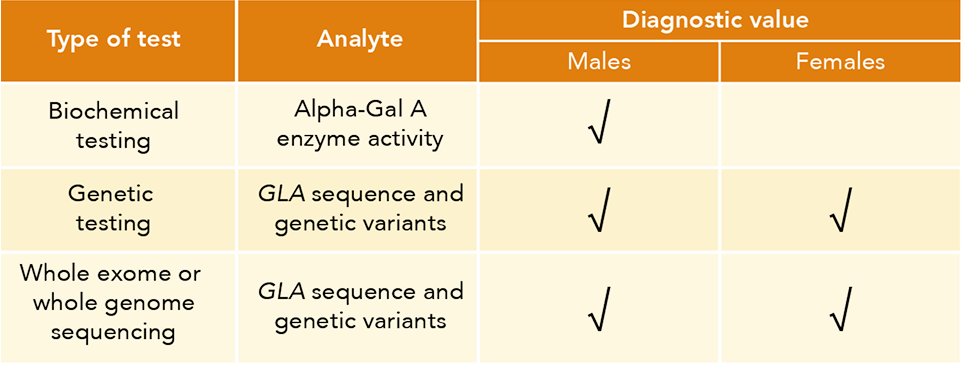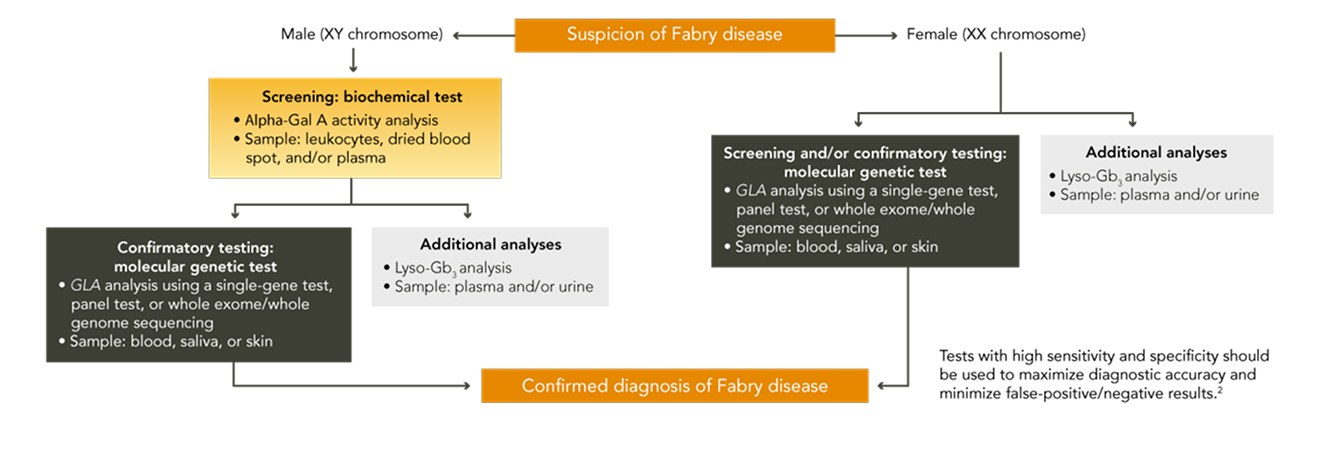

Biochemical testing measures alpha-Gal A enzyme activity and can be used to screen males for Fabry disease.3,4,6,7 In females, alpha-Gal A activity levels may be within the normal range because of random X‑chromosome inactivation affecting one of the two GLA alleles, so biochemical testing may lead to false-negative results.3,4
Genetic testing to identify a pathogenic variant in GLA, the gene that encodes alpha-Gal A, is required to diagnose Fabry disease in females and is appropriate for males as well.3,4 If alpha-Gal A testing is used for initial screening, it should be followed by genetic analysis for GLA variants.4,6,7 Although alpha-Gal A enzyme activity is diagnostic in males, genetic testing to identify the pathogenic variant:

Some GLA variants, referred to as variant(s) of uncertain significance (VUS), have an unclear relationship with clinical disease.10 Some individuals with these variants will have signs and symptoms consistent with Fabry disease, while others may be asymptomatic.12-15 Alpha-Gal A enzyme activity levels may be lower than in individuals without a GLA variant.16 In patients with VUS, clinical, biochemical, or histopathological evidence may be required to confirm Fabry disease.10,15 In addition, a family history of Fabry disease can predict pathogenicity for a GLA VUS.10,15 Consultation with a genetics professional is advised in cases of VUS.10
GLA, galactosidase alpha gene; lyso-Gb3, globotriaosylsphingosine.
References: 1. Mehta A, Beck M, Eyskens F, et al. Fabry disease: a review of current management strategies. QJM. 2010;103(9):641-659. 2. Stiles AR, Zhang H, Dai J, et al. A comprehensive testing algorithm for the diagnosis of Fabry disease in males and females. Mol Genet Metab. 2020;130(3):209-214. 3. Germain DP. Fabry disease. Orphanet J Rare Dis. 2010;5:30. 4. Vardarli I, Rischpler C, Herrmann K, Weidemann F. Diagnosis and screening of patients with Fabry disease. Ther Clin Risk Manag. 2020;16:551-558. 5. Yao F, Hao N, Li D, et al. Long-read sequencing enables comprehensive molecular genetic diagnosis of Fabry disease. Hum Genomics. 2024;18(1):133. 6. Linthorst GE, Bouwman MG, Wijburg FA, Aerts JMFG, Poorthuis BJHM, Hollak CEM. Screening for Fabry disease in high-risk populations: a systematic review. J Med Genet. 2010;47(4):217-222. 7. Maron MS, Xin W, Sims KB, et al. Identification of Fabry disease in a tertiary referral cohort of patients with hypertrophic cardiomyopathy. Am J Med. 2018;131(2):200.e1-200.e8. 8. Gal A, Hughes DA, Winchester B. Toward a consensus in the laboratory diagnostics of Fabry disease – recommendations of a European expert group. J Inherit Metab Dis. 2011;34(2):509-514. 9. Bichet DG, Hopkin RJ, Aguiar P, et al. Consensus recommendations for the treatment and management of patients with Fabry disease on migalastat: a modified Delphi study. Front Med (Lausanne). 2023;10:1220637. 10. Ortiz A, Germain DP, Desnick RJ, et al. Fabry disease revisited: management and treatment recommendations for adult patients. Mol Genet Metab. 2018;123(4):416-427. 11. Mehta A, Hughes DA. Fabry disease. In: Adam MP, Feldman J, Mirzaa GM, eds. GeneReviews. University of Washington, Seattle; 1993–2025. Accessed April 28, 2025. https://www.ncbi.nlm.nih.gov/books/NBK1292 12. Viall S, Dennis A, Yang A. Newborn screening for Fabry disease in Oregon: approaching the iceberg of A143T and variants of uncertain significance. Am J Med Genet C Semin Med Genet. 2022;190(2):206-214. 13. du Moulin M, Koehn AF, Golsari A, et al. The mutation p.D313Y is associated with organ manifestation in Fabry disease. Clin Genet. 2017;92(5):528-533. 14. Sezer O, Ceylaner S. Genetic management algorithm in high-risk Fabry disease cases; especially in female indexes with mutations. Endocr Metab Immune Disord Drug Targets. 2021;21(2):324-337. 15. Zhou H, Wang S, Chen Y, et al. Fabry disease with genetic variants of unknown significance and concomitant immunoglobulin A nephropathy. Kidney Blood Press Res. 2024;49(1):799-811. 16. Klein A, Klug K, Breyer M, et al. Genetic variants of unknown significance in alpha-galactosidase A: cellular delineation from Fabry disease. J Inherit Metab Dis. 2024;47(4):805-817.